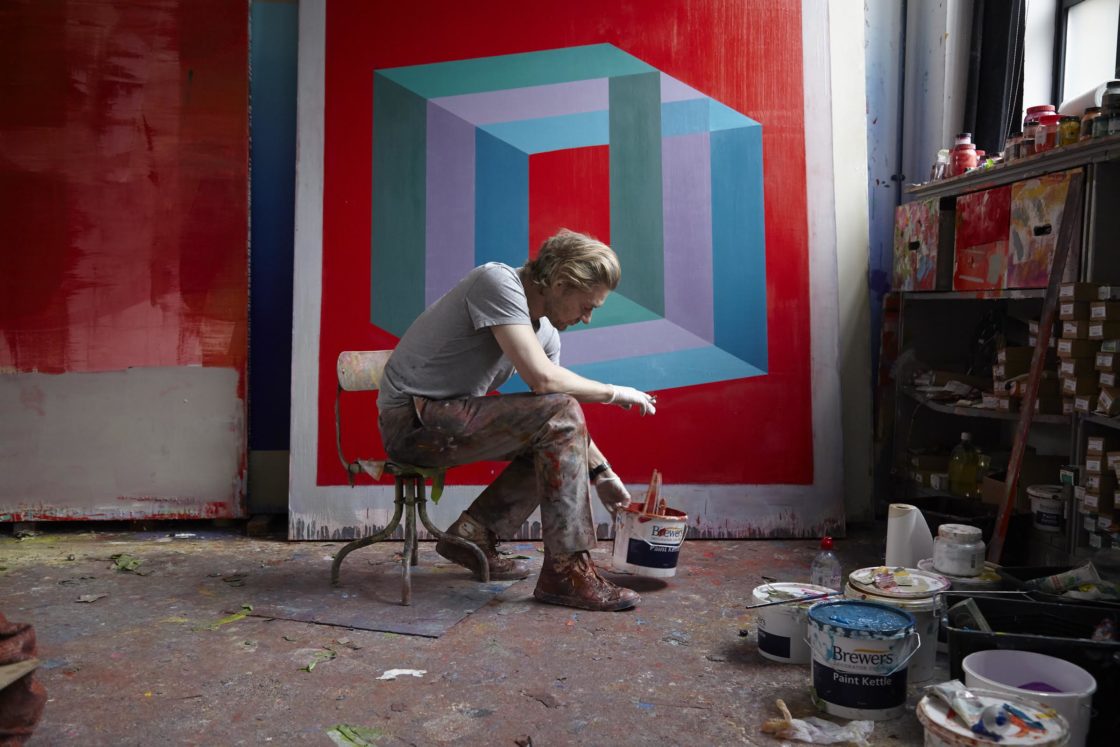In the studio with Harland Miller
Harland Millers large-format oil paintings, tattered book covers with sarcastic, humorous, fictitious titles – based on the Penguin Classics – made the artist and novelist famous quite some time ago. His recent exhibition, One Bar Electric Memoir, is now helping to write the next chapter of his career. “Harland’s paintings make a chuckle gurgle up as your psyche goes deep into your personal narrative reservoir, unearthing bizarre treasures lost below,” states art consultant Hikari Yokoyama about the artist on her Instagram profile, pinpointing exactly why Harland is not just one of my favourite artists, but also a favourite of numerous creative minds, including Jarvis Cocker and Sam Taylor-Johnson. Last year, Harland’s first solo exhibition in Germany was shown at the Berlin branch of Blain Southern. In Tonight We Make History, Harland exhibited for the first time new, large-scale works based on psychology and self-help books of the 1960s and ’70s. With One Bar Electric Memoir at White Cube Gallery in London, the artist is now taking this experiment even further. I visited him in his studio a while ago and talked with Harland about his work.
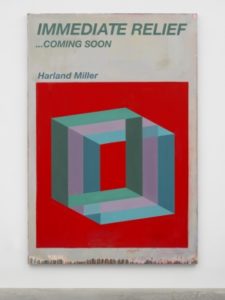
You painted book cover after book cover, year after year. Where does your love for literature and book covers come from?
Harland Miller: I was always painting books actually. I grew up with books all around me, because my dad used to collect books. He worked in a factory; we did not have enough money to collect books, but he collected them in a way he could. He would go to salesrooms in Leeds and buy a big box of books for five quid. He didn’t know what was in the box, so it could be anything. He always hoped there would be a really valuable edition in the box. There never was actually …
What kind of books did he find in the boxes?
Harland Miller: He got a real variety of books, classics but reprinted in paperback. There was this kind of mixture of highbrow and lowbrow, and my dad always tipped these books out onto the floor and looked amongst them, searching for this priceless first edition that he thought he was going to find, but he never did. And then he sort of kicked it and said it’s all rubbish. But because he never threw anything away, even if it was rubbish, I was organizing the books, not according to genre, but by whether they have cars on the cover or not. For example, this F. Scott Fitzgerald novel with a 1920 roadster I’d put in a pile, then the next could have been borderline pornograhy, with a girl lying on a car, or a book about how to fix cars. I was young, maybe eight, and I sorted piles according to my imagery. And I think that mixture of high and lowbrow references actually stayed in my work.
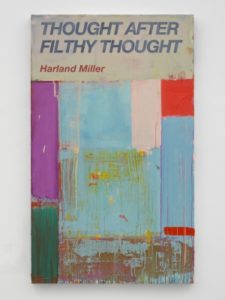
The book covers you paint often contain nostalgia and humour. Both are things that one doesn’t normally find that much in contemporary art …
Harland Miller: I think it’s perhaps because people don’t like to trust their emotions when they look at work. I think they prefer to have a cerebral response to work, rather than an emotional one. Emotions are not trustworthy. We have to be careful – wary of them – because they might take us the wrong way. You are more accountable when you’re making work that acquires a response. Nostalgia and humour, I think those two things are difficult for the artwork. But that’s not why I decided to use them in my work. It just happened that way. Books were always an important part of my life. Humour was too, where I grew up. It was an industrial town. People saw life as carnage, just one long, ongoing difficulty – relieved here and there with humour, black humour.
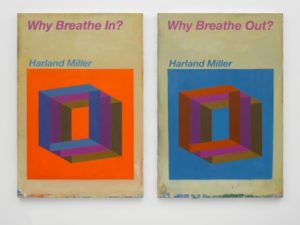
Probably people living in that industrial city did read a lot of the Penguin Classics, which were the inspiration for the book cover paintings you are well known for …
Harland Miller: When I was a kid, classics were reprinted and made in this cheap way, made affordable for working men, so they could read classics without going to the library or going to a bookshop and buying a hardcover. They were famous for costing the same as a pack of cigarettes. I grew up around them; I never really thought about them too much. But you know, later on I moved to Paris and during this time I was painting books, which had this sort of B movie imagery of blondes lying in motels, on the bed, could be dead, or not. I was painting this stuff when I moved to Paris and it went straight to appropriation. When I got to Paris there were lots of these books, along the left bank, in the secondhand shops. So I bought them. There was no problem getting ahold of that kind of reference material, but the thing was that I never really understood the title, so I never knew if the title appealed to me, because I did not speak French at the time. At that point I started to invent the title myself. I think it was kind of an awakening moment, without me realizing it though. I invented a text that suggested a story – a whole narrative – which suggested the way in which I should paint the painting. I found that it seemed to be more interesting than what I’d been doing before.
What role do design, text and colour play in your Penguin paintings?
Harland Miller: I wanted people to concentrate so much on the text and the actual imagery took away from it a little bit. Then I found out there was an English bookseller in Paris and I went there and instead of looking through the books, I just bought the whole box. I went to my studio and emptied them out on the floor. They were all these Penguin books and that format was really doing what I wanted: it was throwing the focus on the title. You almost had this lack of design, and then you had these colours above and below it. I think what I did not realise at first was how much the colour changed the way in which people read the work. Then I found out that if I used the text again, but added a different colour, it really would change the way in which people read the text. That was one of the ways in which it began to become a series.
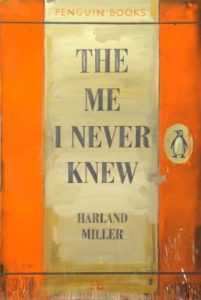
Some of your paintings are really large in scale …
Harland Miller: Scale is something that people worry about, because they think it sort of can be made for the sake of it. I think if you’re working with an idea of a narrative, then you’re working with something life-size. If your past were on fire would you go back to save it was a really good example of that. It does evoke the kind of image that your house is on fire, and you stand in front of it and everything is going through your mind.
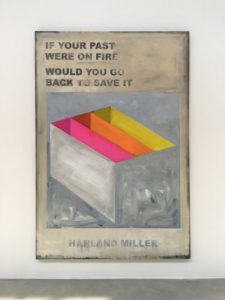
One of your older paintings has the title International lonely guy. Your company has the same name, as well as your Instagram account. What is the story behind this title?
Harland Miller: International lonely guy was a character I invented when I was moving around a lot, living in different places, staying in impersonal kind of hotels, not knowing anyone and spending a lot of time on my own in restaurants, bars, cheap hotels and that sort of thing. It’s a character I invented to take the slack of all of that … that boredom kind of way. He was kind of a hard-boiled character, like a Raymond Chandler character, a William S. Burroughs character. Lots of talking but nothing was really happening. I actually came up with this character when I moved to the Meatpacking District in New York.
The Meatpacking District has changed a lot since then. How do you remember it, what kind of experiences did you have while living there?
Harland Miller: It was at the end of the eighties when it really was a Meatpacking District. There were transvestites and prostitutes cruising the street, there were the transsexual hookers … There were also a lot of Vietnam vets who lived under a bridge at the end of the road and when the weather would get bitterly cold, with the wind blowing in under the tunnel where the guys were living, the Salvation Army would turn up to give them soup. They called them the the soup van; they gave you jam sandwiches. During this time I was quite broke and I had an atelier there, so sometimes when things were not going well, I actually went down and joined the queue. I wasn’t homeless, but I was joining this queue for sandwiches, and that way I got to know some of the hookers. I befriended these guys – girls – and they took me to this café around the corner. The guy who runned it was called Jerry and he liked to keep a certain kind of tone to the café. So he had hookers and truckers there, and people swearing a lot. He put up this sign: ‘No profound language’, which was great, because obviously he meant profane. But who was going to tell him? I liked the way that sign worked; it had a double meaning. That’s how I play with phrases. I took a word like ‘international’ and some words that don’t follow on from international at all. The opposite of what you normally think would follow on international. I suppose ‘international stardom’ is something you would think of normally. ‘International lonely guy’ was really more the truth of where I was at and that seemed to describe myself.
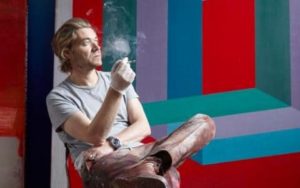
You don’t just paint book covers; you also write a lot. You’ve published novels and some articles …
Harland Miller: I actually started writing when I was living in Berlin. When I first moved to Berlin I didn’t speak any German. I was living in eastern Berlin; people didn’t speak a lot of English either. I don’t know if you’ve ever done that, go somewhere where you’re isolated so that you’re in your own bubble a lot of the time. I started keeping a diary – maybe out of homesickness. Starting the diary triggered some memories from something that happened a long time ago, and, without realising it, I ended up writing a couple of pages about something that had happened years ago. After a few months I had written something that was almost like my childhood memoir. A lot of the text that appears in my paintings comes from my writings, especially the ones I never published, maybe never will publish. And actually all titles I use could be titles of stories I might write one day, or probably never will. There are just too many of them!
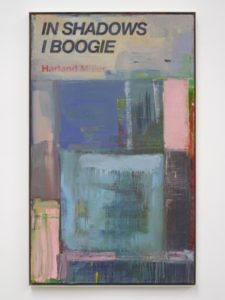
How did you feel back then, moving to and living in Berlin?
Harland Miller: In moving to Germany, I was looking for isolation, and the funny thing was I kind of found the opposite. I had the idea to go to Germany: the wall had come down and I imagined I would move to east of the wall and live in the deserted streets. I obviously had a romantic view. But others had the same idea. When I arrived, I met a lot of people who did exactly the same thing. It was a social time. To start with, when I got there, I did not immediately meet these people. There was a period of isolation at the beginning, which I didn’t mind. I lived in different countries before and had the same experience. I knew from my experience that isolation doesn’t last so long. Eventually you meet people, you learn the language, you don’t go somewhere and stay isolated unless you want to …
Lately you kind of abandoned the Penguins in your exhibition and have focused more on psychology and self-help books of the 1960s and ’70s …
The works themselves are a continuation of a theme, based on book jackets. The intention was to throw all the attention directly onto the text. I wanted people to read the text and react to that first – but then I realised: that’s what people do anyway. People can’t help but read the text: you might not even think you see it, but subconsciously it’s just something your brain does. It reads text before you can stop doing it. You have to make yourself conscious to NOT read the text. And that’s the big difference in which people normally look at art, I think. Before, my paintings used to be purely abstract, people used to ask me what my work was about. They asked: What does it mean? What does your work mean? Now I find that people tell me what it means to them.
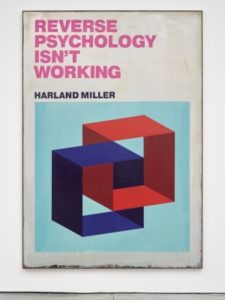
How does that feel to you?
Harland Miller: I prefer it actually. People write to me and tell me they have a painting, or they have seen a painting of mine, and it means this to them or that to them, and they are very happy to tell me that, without asking me what it means. I really prefer that. I especially like it, because for me, there are at least two meanings to the text.There may be many more, but there are at least two. I think in these new works I devised these sort of diagrammes or symbols and I think the symbol itself can be read. You can read them in two ways: they have this kind of flip-flop effect, like a kind of trick to how you look at them, and you can read them in two ways, and they have this kind of 1960s feel. For me they are symbolic of how I wanted people to read the text. To read it in one way and to see that there is a subtext to it, there is another way of interpreting it. That is the difference between the previous works and the works I have done lately.
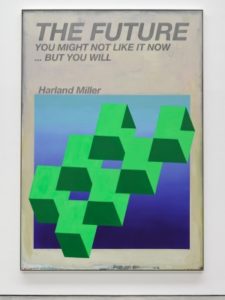
Watch my short film about Harland on Youtube. You can find more interesting studio reports on the Arte Website.

